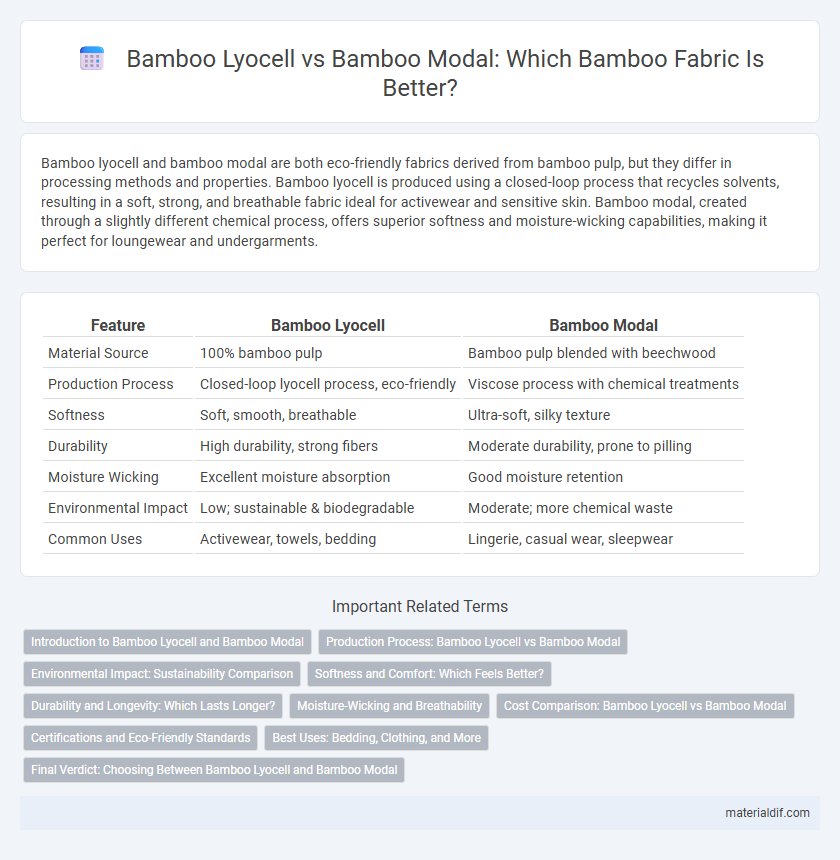Bamboo lyocell and bamboo modal are both eco-friendly fabrics derived from bamboo pulp, but they differ in processing methods and properties. Bamboo lyocell is produced using a closed-loop process that recycles solvents, resulting in a soft, strong, and breathable fabric ideal for activewear and sensitive skin. Bamboo modal, created through a slightly different chemical process, offers superior softness and moisture-wicking capabilities, making it perfect for loungewear and undergarments.
Table of Comparison
| Feature | Bamboo Lyocell | Bamboo Modal |
|---|---|---|
| Material Source | 100% bamboo pulp | Bamboo pulp blended with beechwood |
| Production Process | Closed-loop lyocell process, eco-friendly | Viscose process with chemical treatments |
| Softness | Soft, smooth, breathable | Ultra-soft, silky texture |
| Durability | High durability, strong fibers | Moderate durability, prone to pilling |
| Moisture Wicking | Excellent moisture absorption | Good moisture retention |
| Environmental Impact | Low; sustainable & biodegradable | Moderate; more chemical waste |
| Common Uses | Activewear, towels, bedding | Lingerie, casual wear, sleepwear |
Introduction to Bamboo Lyocell and Bamboo Modal
Bamboo lyocell is a sustainable fabric made from bamboo pulp using a closed-loop process that recycles water and solvents, resulting in an eco-friendly textile with a smooth, soft texture and excellent breathability. Bamboo modal, derived from beechwood fibers, shares similar softness and moisture-wicking properties but involves a more chemical-intensive production process compared to lyocell. Both fabrics offer biodegradable and hypoallergenic benefits, making them popular choices in sustainable fashion and activewear.
Production Process: Bamboo Lyocell vs Bamboo Modal
Bamboo lyocell is produced using a closed-loop process that dissolves bamboo pulp with non-toxic solvents, ensuring minimal environmental impact and high fiber purity. Bamboo modal undergoes a more chemically intensive procedure involving sodium hydroxide and carbon disulfide, which can generate higher levels of industrial waste. Both processes transform bamboo into soft, breathable fibers, but lyocell's sustainable production offers superior eco-friendly credentials compared to modal.
Environmental Impact: Sustainability Comparison
Bamboo lyocell and bamboo modal differ significantly in environmental impact, with bamboo lyocell recognized for its closed-loop production process that recycles 99% of solvents, minimizing chemical waste and water pollution. Bamboo modal generally involves a more chemical-intensive process with lower solvent recovery rates, contributing to higher ecological footprints. Bamboo lyocell's sustainable manufacturing reduces carbon emissions and water usage, aligning with eco-friendly textile standards more closely than bamboo modal.
Softness and Comfort: Which Feels Better?
Bamboo lyocell offers superior softness and breathability, making it ideal for sensitive skin and all-day comfort. Bamboo modal is also soft but tends to have a silkier texture, providing a smooth, luxurious feel against the skin. For maximum comfort, bamboo lyocell is often preferred due to its enhanced moisture-wicking and hypoallergenic properties.
Durability and Longevity: Which Lasts Longer?
Bamboo lyocell fibers offer superior durability due to advanced processing techniques that retain fiber strength, resulting in longer-lasting fabric compared to bamboo modal. Bamboo modal tends to have a softer hand feel but is more prone to pilling and wear over time, reducing its lifespan. Consumers seeking longevity in bamboo textiles should prioritize lyocell options for enhanced fabric resilience and extended product life.
Moisture-Wicking and Breathability
Bamboo lyocell fibers exhibit superior moisture-wicking properties and enhanced breathability compared to bamboo modal, making them ideal for activewear and performance fabrics. The lyocell production process maintains the fiber's natural structure, resulting in better moisture absorption and faster evaporation. Bamboo modal, while soft and durable, typically retains more moisture, leading to less effective breathability in warm or humid conditions.
Cost Comparison: Bamboo Lyocell vs Bamboo Modal
Bamboo lyocell generally costs more than bamboo modal due to its eco-friendly closed-loop production process that minimizes chemical use. Bamboo modal, produced through a more conventional viscose method, offers a lower price point while maintaining softness and durability. Pricing variations depend on factors like production scale, supplier, and fabric quality, but lyocell's sustainable manufacturing justifies its premium cost in the market.
Certifications and Eco-Friendly Standards
Bamboo lyocell is often certified by OEKO-TEX(r) Standard 100 and FSC, reflecting its sustainable closed-loop manufacturing process that recycles 99% of solvents and water. Bamboo modal typically holds certifications such as FSC and GOTS, emphasizing its organic raw material sourcing and eco-friendly dyeing methods. Both fibers prioritize reducing chemical usage and water consumption, but lyocell's closed-loop solvent recovery system offers a higher environmental standard in eco-friendly textiles.
Best Uses: Bedding, Clothing, and More
Bamboo lyocell excels in bedding and activewear due to its smooth texture, moisture-wicking properties, and eco-friendly production process. Bamboo modal, known for its softness and durability, is ideal for clothing like underwear, casual wear, and luxury linens. Both fibers offer breathable comfort, but lyocell's higher wet strength makes it preferable for items requiring longevity and frequent washing.
Final Verdict: Choosing Between Bamboo Lyocell and Bamboo Modal
Bamboo lyocell offers superior environmental benefits due to its closed-loop production process, making it more sustainable than bamboo modal, which uses chemical solvents in its manufacturing. Bamboo lyocell fibers are softer, stronger, and more moisture-wicking, ideal for high-performance and eco-friendly textiles. Choosing between bamboo lyocell and bamboo modal depends on prioritizing either sustainability and durability or budget-friendly softness and drape.
Bamboo lyocell vs bamboo modal Infographic

 materialdif.com
materialdif.com